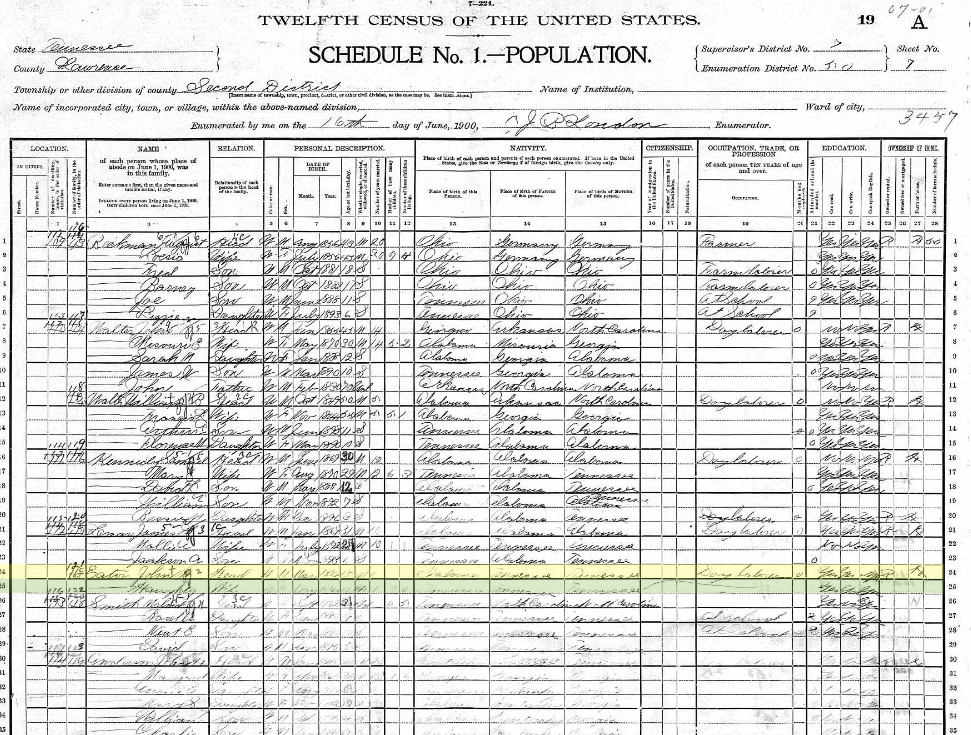At the start of a new century and 110 years since the first U.S. census of 1790, we have the 1900 U.S. census. This census saw a return to the format that many of the previous censuses had used. Gathered information was returned to rows rather than columns with families listed sequentially in the order of visitation by the enumerator.
After the census was completed, the Census Bureau was formed and became a part of the U.S. Department of Commerce and Labor and a permanent agency. The purpose of this change was to reduce duplication in work across multiple departments of the government.
Table of Contents
Questions for the 1900 U.S. Census
The census questions asked were similar to previous censuses without too many differences. FamilySearch lists the questions asked. This census asks two questions that can help with determining immigration – foreign birth and year of immigration. While the information supplied is not always accurate, it can offer a place to start when looking for other records.
Another question is asked of the women – how many children born and how many living. The answers to these questions can help identify potentially missing family members. This is next to the question on the years married. For blended families these questions can provide insight and possible clarity on whether a woman is the biological mother of the listed children or not.
Another new bit of information is the month and year of birth. This is nice because it gives almost a complete birth date with those two data points. For individuals that do not have birth information, this is a great source. Caution is warranted because those dates may not be entirely accurate. Still, a place to start.
Missing Records
That National Archives does not have any information pages for the 1900 U.S. census. The FamilySearch Research Wiki article states that all of the states and territories were included in the census. Based on that article no states have missing data. It is possible that there are missing records or missing individual enumeration sheets.
The census has been digitized and indexed. It is available at all the major genealogical sites.
Statistics
The 1900 U.S. census shows the total U.S. population increased to 76,212,168, up about 22% from the last census count. New York City and Brooklyn were combined for a total city population of over 3 million people. New York was the most populous state and Nevada the least populous. The Wikipedia article has additional state and city statistics.
A look at John Henry Eaton

John Henry Eaton was born 16 March 1882 in Greenhill, Lauderdale, Alabama. His parents were William Jasper Eaton and Rhoda Emily VanPelt. His mother died when he was only about 4 years old. His father remarried to Mariah Hannah Smith, who raised John Henry. He had a seven half-siblings.
John Henry married Hautie Lou Smith 7 January 1899 in Lawrence County, Tennessee. Mariah was Hautie Lou’s aunt. When the 1900 U.S. Census was taken, John Henry and Hautie Lou had only been married 1 year and were still living in Lawrence County, Tennessee. They did not have any children at that point.
The 1900 U.S. Census1 shows that John Henry was living in a rented home and was working as a day laborer, most likely on a farm. He also could have taken odd jobs as a carpenter as he did either of those things over the course of his life. John Henry and Hautie Lou could both read and write.

The census states that John Henry was born in Alabama and his parents in Tennessee. His mother likely was born in Tennesse, but his father was born in Alabama based on the census data for his father. Greenhill, Lauderdale, Alabama is located along the Tennessee-Alabama border. It was common for the people in this area to travel between Lauderdale County, Alabama and Lawrence County, Tennessee regularly. This is one example that demonstrates the reason to view census data with caution while looking for other supporting documentation.
Sources
- 1900 U.S. Census, Lawrence, Tennessee, population schedule, township 2nd District, enumeration district (ED) 50, sheet 7A (penned), dwelling 115, family 121, John H Eaton; digital image, Ancestry, (http://www.ancestry.com accessed 30 Jun 2023); citing NARA microfilm publication T623, roll 1584:







One response to “A good look at the 1900 U.S. Census”
[…] looked at John Henry Eaton in the 1900 U.S. census.1 In 1900 John Henry and his wife Hautie Lou were newly married with no children. They were living […]